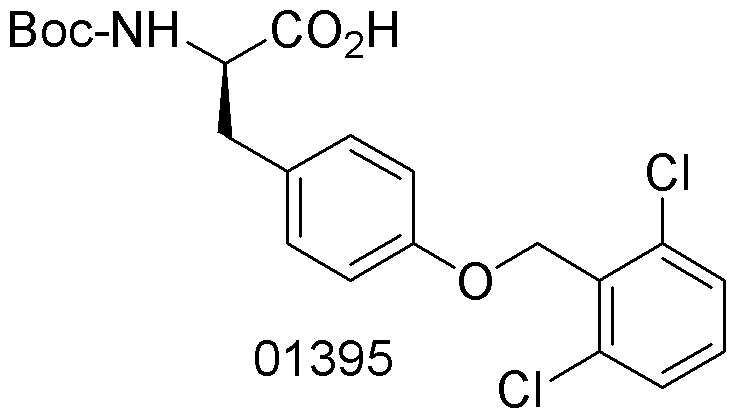Boc-O-2,6-dichlorobenzyl-D-tyrosine is widely utilized in research focused on:
- Peptide Synthesis: This compound serves as a valuable building block in the synthesis of peptides, particularly in the development of therapeutic agents. Its unique structure allows for the incorporation of specific functionalities that enhance biological activity.
- Drug Development: In pharmaceutical research, it is used to create novel drug candidates targeting various diseases. The compound's ability to modify receptor interactions makes it a key player in designing more effective medications.
- Bioconjugation: It is employed in bioconjugation processes, where it helps link biomolecules to therapeutic agents. This application is crucial in creating targeted therapies that improve treatment efficacy while minimizing side effects.
- Research in Cancer Treatment: The compound is explored in studies aimed at developing new cancer therapies. Its properties can be leveraged to enhance the selectivity and potency of anticancer drugs, addressing the challenge of drug resistance.
- Biochemical Assays: Boc-O-2,6-dichlorobenzyl-D-tyrosine is used in various biochemical assays to study enzyme activities and interactions. Its role in these assays provides insights into metabolic pathways and potential therapeutic targets.
Informations générales
Propriétés
Sécurité et réglementation
Applications
Boc-O-2,6-dichlorobenzyl-D-tyrosine is widely utilized in research focused on:
- Peptide Synthesis: This compound serves as a valuable building block in the synthesis of peptides, particularly in the development of therapeutic agents. Its unique structure allows for the incorporation of specific functionalities that enhance biological activity.
- Drug Development: In pharmaceutical research, it is used to create novel drug candidates targeting various diseases. The compound's ability to modify receptor interactions makes it a key player in designing more effective medications.
- Bioconjugation: It is employed in bioconjugation processes, where it helps link biomolecules to therapeutic agents. This application is crucial in creating targeted therapies that improve treatment efficacy while minimizing side effects.
- Research in Cancer Treatment: The compound is explored in studies aimed at developing new cancer therapies. Its properties can be leveraged to enhance the selectivity and potency of anticancer drugs, addressing the challenge of drug resistance.
- Biochemical Assays: Boc-O-2,6-dichlorobenzyl-D-tyrosine is used in various biochemical assays to study enzyme activities and interactions. Its role in these assays provides insights into metabolic pathways and potential therapeutic targets.
Documents
Fiches de données de sécurité (FDS)
La FDS fournit des informations de sécurité complètes sur la manipulation, le stockage et l’élimination du produit.
Spécifications du produit (PS)
Le PS fournit une description complète des propriétés du produit, notamment sa composition chimique, son état physique, sa pureté et les exigences de stockage. Il détaille également les plages de qualité acceptables et les applications prévues du produit.
Certificats d'analyse (COA)
Recherchez des certificats d'analyse (COA) en saisissant le numéro de lot du produit. Les numéros de lot et de lot se trouvent sur l'étiquette d'un produit, après les mots « Lot » ou « Lot de fabrication ».
Numéro de catalogue
Numéro de lot/série
Certificats d'origine (COO)
Ce certificat d'exploitation confirme le pays dans lequel le produit a été fabriqué, et détaille également les matériaux et composants utilisés et s'il est issu de sources naturelles, synthétiques ou autres sources spécifiques. Ce certificat peut être requis pour les douanes, le commerce et la conformité réglementaire.
Numéro de catalogue
Numéro de lot/série
Fiches de données de sécurité (FDS)
La FDS fournit des informations de sécurité complètes sur la manipulation, le stockage et l’élimination du produit.
DownloadSpécifications du produit (PS)
Le PS fournit une description complète des propriétés du produit, notamment sa composition chimique, son état physique, sa pureté et les exigences de stockage. Il détaille également les plages de qualité acceptables et les applications prévues du produit.
DownloadCertificats d'analyse (COA)
Recherchez des certificats d'analyse (COA) en saisissant le numéro de lot du produit. Les numéros de lot et de lot se trouvent sur l'étiquette d'un produit, après les mots « Lot » ou « Lot de fabrication ».
Numéro de catalogue
Numéro de lot/série
Certificats d'origine (COO)
Ce certificat d'exploitation confirme le pays dans lequel le produit a été fabriqué, et détaille également les matériaux et composants utilisés et s'il est issu de sources naturelles, synthétiques ou autres sources spécifiques. Ce certificat peut être requis pour les douanes, le commerce et la conformité réglementaire.


